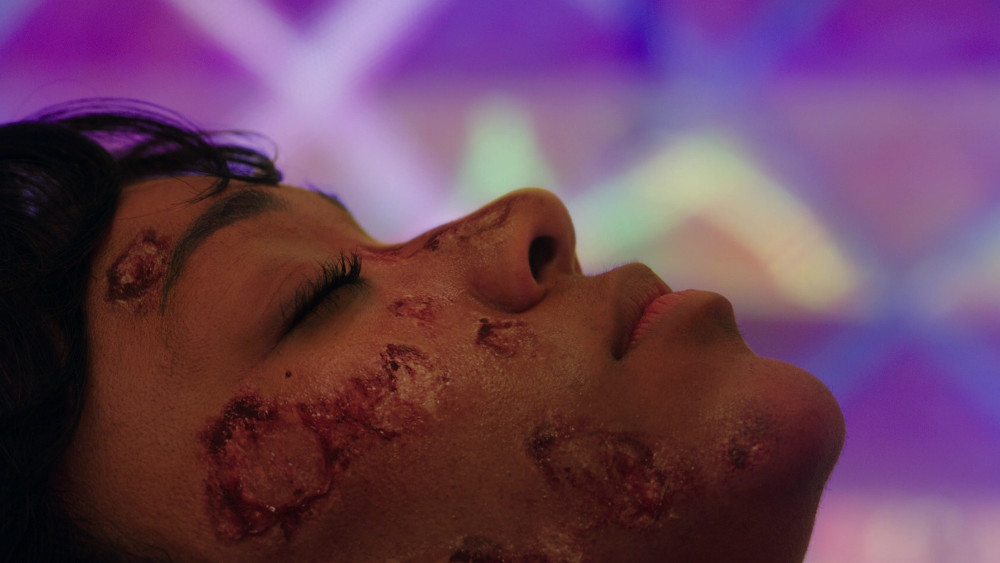Difference between revisions of "radiation sickness"
m |
m |
||
| Line 4: | Line 4: | ||
|}</div> | |}</div> | ||
{{BannerPrime}} | {{BannerPrime}} | ||
| − | [[Radiation]] exposure could have profound effects on living tissue, depending on the type and amount of radiation. Radiation sickness was a consequence of exposure to high doses of radiation, typically from naturally radioactive substances, such as [[radium]], or high-energy electromagnetic sources, such as [[x-rays]]. Radiation exposure could, in some circumstances, lead to cancer and other illnesses by damaging the [[DNA]] in a cell's nucleus. Radiation sickness was characterized by nausea, vomiting, loss of appetite, diarrhea, fever, and weakness. In advanced cases, internal hemorrhaging due to tissue damage could occur,<ref name="STSL"/> with more extreme cases causing a person's DNA to "unspool like noodles."<ref name="DSC01"/> Radiation exposure could also burn skin and other tissues, and the burns were treated the same as any other kind of burn. Radiation sickness was typically treated with basic supportive measures, such as fluid replacement and blood transfusions,<ref name="STSL"/> and in extreme cases, advanced techniques in DNA resequencing.<ref name="DSC01"/> | + | [[Radiation]] exposure could have profound effects on living tissue, depending on the type and amount of radiation. Radiation sickness was a consequence of exposure to high doses of radiation, typically from naturally radioactive substances, such as [[radium]], or high-energy electromagnetic sources, such as [[x-rays]]. Radiation exposure could, in some circumstances, lead to cancer and other illnesses by damaging the [[DNA]] in a cell's nucleus. Radiation sickness was characterized by nausea, vomiting, loss of appetite, diarrhea, fever, and weakness. In advanced cases, internal hemorrhaging due to tissue damage could occur,<ref name="STSL"/> with more extreme cases causing a person's DNA to "unspool like noodles."<ref name="DSC01"/> Radiation exposure could also burn skin and other tissues,<ref name="TOS19"/> and the burns were treated the same as any other kind of burn. Radiation sickness was typically treated with basic supportive measures, such as fluid replacement and blood transfusions,<ref name="STSL"/> and in extreme cases, advanced techniques in DNA resequencing.<ref name="DSC01"/> |
{{References}} | {{References}} | ||
<references> | <references> | ||
| + | <ref name="TOS19">{{RefTOS19}}</ref> | ||
<ref name="STSL">{{RefSTSL}}</ref> | <ref name="STSL">{{RefSTSL}}</ref> | ||
<ref name="DSC01">{{RefDSC01}}</ref> | <ref name="DSC01">{{RefDSC01}}</ref> | ||
| Line 13: | Line 14: | ||
[[Category:Science & Technology]] | [[Category:Science & Technology]] | ||
[[Category:Science]] | [[Category:Science]] | ||
| + | [[Category:TOS]] | ||
[[Category:DSC]] | [[Category:DSC]] | ||
[[Category:Books]] | [[Category:Books]] | ||
[[Category:Film]] | [[Category:Film]] | ||
[[Category:Prime Timeline]] | [[Category:Prime Timeline]] | ||
Latest revision as of 07:26, 5 September 2023
| First Appearance | TOS09 (15 Dec 1966) |
| Advertising |
Radiation exposure could have profound effects on living tissue, depending on the type and amount of radiation. Radiation sickness was a consequence of exposure to high doses of radiation, typically from naturally radioactive substances, such as radium, or high-energy electromagnetic sources, such as x-rays. Radiation exposure could, in some circumstances, lead to cancer and other illnesses by damaging the DNA in a cell's nucleus. Radiation sickness was characterized by nausea, vomiting, loss of appetite, diarrhea, fever, and weakness. In advanced cases, internal hemorrhaging due to tissue damage could occur,[1] with more extreme cases causing a person's DNA to "unspool like noodles."[2] Radiation exposure could also burn skin and other tissues,[3] and the burns were treated the same as any other kind of burn. Radiation sickness was typically treated with basic supportive measures, such as fluid replacement and blood transfusions,[1] and in extreme cases, advanced techniques in DNA resequencing.[2]
Notes and References
- ↑ 1.0 1.1 Bormanis, Andre. Star Trek: Science Logs. Pocket Books, March 1998.
- ↑ 2.0 2.1 Fuller, Bryan et al (Executive Producers). "The Vulcan Hello". Star Trek: Discovery, season 1, episode 1 (Production number 01). Directed by David Semel. Story by Bryan Fuller & Alex Kurtzman. Teleplay by Bryan Fuller & Akiva Goldsman. CBS Entertainment. 24 September 2017.
- ↑ Roddenberry, Gene (Executive Producer). "Arena." Star Trek, Season 1, Episode 18 (Production 19). Directed by Joseph Pevney. Story by Fredric Brown. Teleplay by Gene L. Coon. Desilu Productions, 19 January 1967.

